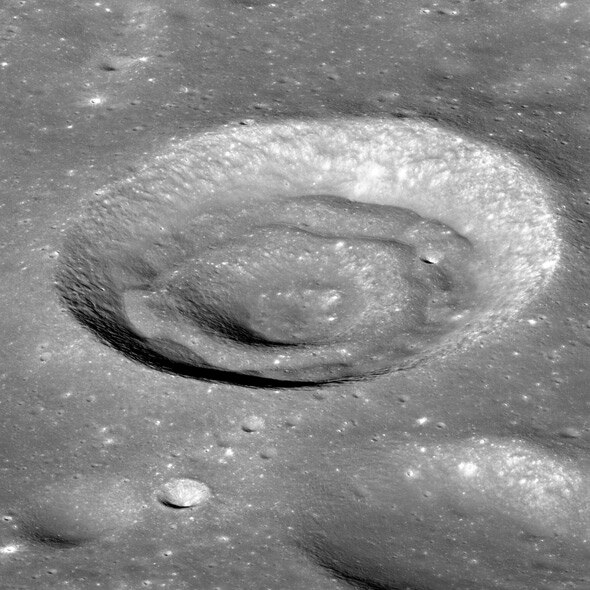Create a free profile to get unlimited access to exclusive videos, sweepstakes, and more!
A Weird Angle on a Weird Crater

The Lunar Reconnaissance Orbiter has been circling the Moon since 2009 and has taken approximately eleventy kajillion pictures of the lunar surface. They’re all pretty amazing, and it’s seen some incredible things. But of all of the images LRO has taken, I think my favorites are the ones where an object is seen at an oblique angle. The main camera is designed to look straight down, so that circular craters always look round, but sometime the angle is changed so that craters are seen more from the side.
When that happens, you get some pretty cool shots, like this one of an unnamed crater about 11.5 kilometers (7 miles) across, located in the Moon’s southern hemisphere:
That picture was taken from an angle 57° away from vertical, so the crater is foreshortened. Still, it looks weird, doesn’t it? The crater rim looks normal enough, pitted with smaller impact craters and being slowly eroded by micrometeorites, the solar wind, and the day/night thermal cycle pulverizing rocks over the eons.
But the floor is odd. Instead of being flat, like some craters, or dropping down into a bowl shape, there’s that peculiar humped ridge running along the inside of it (it looks like part of the wall of the crater has slumped, too, causing those pile-ups around the slope). It almost looks like there’s another ring inside of that one, too. What causes this?
Actually, the physics of creating double or multiple ringed craters isn’t well understood. However, it seems like a good bet that they’re due to an impact from a comet or asteroid into terrain that’s layered. Instead of a single layer of rock, there may be a layer underneath the surface made of some other material. If the layers have different structural strengths, they’ll each make a ring; the surface layer will make the outer rim, and the inner layer will make the inner ring.
On Mars, this is seen when rock overlays ice. The Moon doesn’t have a thick ice layer under the rock, though. Interestingly, this lunar crater sits in the Apollo Basin, a huge, flat area about 500 km (300 miles) across. Basins on the Moon are caused by enormous impacts from asteroids or comets themselves dozens of kilometers across (way bigger than the one that wiped out the dinosaurs). The impact can punch a hole through the Moon’s crust, and lava can partially fill the impact crater. That gives the impact site a flat interior, and you can see that’s true for Apollo … as well as it being double-ringed as well! That sometimes happens in very large impacts, and the physics of why that happens is even less well-understood than for smaller ones.
The unnamed crater sits about halfway between the Apollo Basin’s inner ring and outer rim. It’s possible that the surface there is layered, but interestingly other craters in the area don’t show that double ring structure. Maybe the layering under the unnamed crater is local. Maybe something else is at play here. It’s hard to say.
And one final point. The crater we’re looking at here is 11.5 km across, 10 times wider than the famous Barringer Meteor Crater in Arizona. The diameter of a crater increases roughly as the cube root of the energy of the explosion, so the rock that smacked into the Moon to make this crater did so with 1,000 times the energy of whatever made Barringer … which was itself equivalent to roughly a 15 megaton bomb!
Whatever carved out this crater on the Moon, it did so with a single explosion far larger than every nuclear weapon on Earth combined. And yet, on the Moon there are so many craters that size (or far bigger) that no one has even bothered to give this one a name.
The history of the solar system is violent. And yet it has spawned incredible beauty.


























